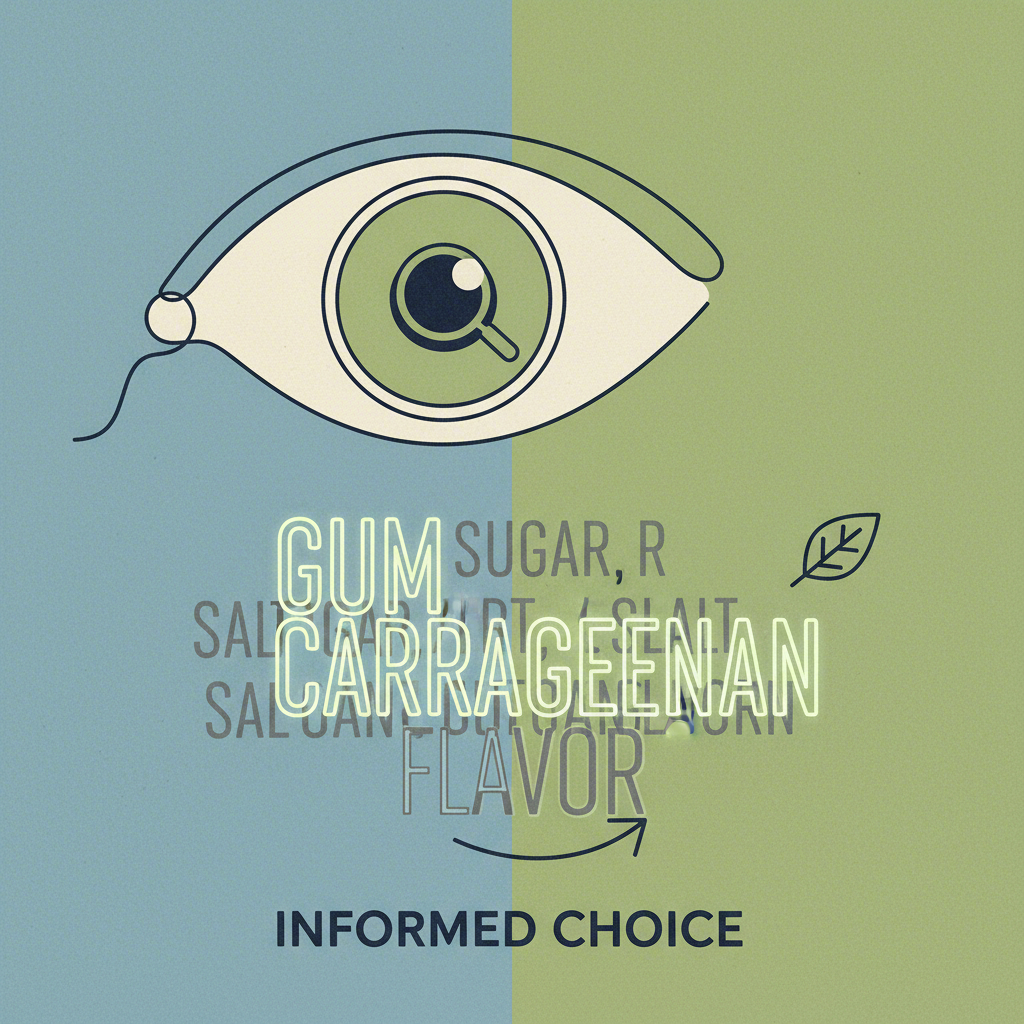TL;DR
Soy milk often contains thickeners like guar gum, gellan gum, xanthan gum, and carrageenan. Manufacturers add these ingredients, also known as hydrocolloids or gums, to improve the texture and create a creamier mouthfeel. They also serve as stabilizers to prevent the natural separation of water and solids, ensuring a consistent product from the first pour to the last.
Understanding Thickeners: Why Are They Added to Soy Milk?
When you scan the ingredient list on a carton of soy milk, you might notice words that seem more at home in a science lab than a kitchen. Terms like gellan gum, locust bean gum, and carrageenan are common, and they all fall under the category of thickeners, stabilizers, or emulsifiers. In the context of plant-based milks, these ingredients are food additives—often derived from natural sources like beans, seaweed, or bacterial fermentation—that serve several key functions to improve the final product.
The primary reason for their inclusion is to enhance texture and consistency. Homemade or minimally processed soy milk has a tendency to be thin and watery, and its components can separate over time, leaving a layer of sediment at the bottom. Commercial producers use thickeners to create a richer, creamier mouthfeel that more closely mimics traditional dairy milk. These additives, which are a type of polysaccharide, work by binding with water to form a gel-like network, which gives the soy milk its smooth and uniform body.
Beyond texture, these agents act as stabilizers and emulsifiers. This means they keep the soy proteins and fats suspended evenly throughout the liquid, preventing them from settling. This process ensures that every glass you pour has the same consistency without needing to be shaken vigorously beforehand. Without these hydrocolloids, your soy milk would likely separate into distinct layers, which is perfectly natural but often unappealing to consumers. You can spot these ingredients by carefully reading the nutrition label on any store-bought plant-based milk.
A Guide to the Most Common Thickeners in Soy Milk
While many different gums and stabilizers exist, a few appear consistently on soy milk labels. Each has a unique origin and set of properties that make it suitable for creating a smooth, stable beverage. Understanding what they are can help you make more informed decisions as a consumer. Many of these ingredients also function as emulsifiers, helping to keep fats and water blended together.
Guar Gum
Derived from guar beans, a legume native to Asia, guar gum is a popular cold-soluble thickener. It is effective at increasing viscosity at low concentrations and contributes to a creamier texture. However, some studies have noted that in high doses, it can cause digestive discomfort such as gas and bloating. Beyond plant milks, it’s also used in products like ice cream and salad dressings. Elmhurst 1925 notes that while it’s generally considered safe in small amounts, it offers no real nutritional value.
Gellan Gum
Gellan gum is produced through the bacterial fermentation of a carbohydrate source. It’s a highly effective gelling agent and stabilizer, often used to keep plant-based milks from separating and to suspend added nutrients like calcium. According to Healthline, it’s a common additive that ensures a uniform mixture and texture. Like other gums, it is approved by the FDA, though some animal studies have raised questions about its effects on the digestive tract at very high concentrations.
Locust Bean Gum
Also known as carob bean gum, this thickener is extracted from the seeds of the carob tree. It is prized for its ability to create a rich texture and prevent the formation of ice crystals in frozen desserts. It is often used in combination with other gums, like xanthan gum, to enhance their effects. One potential downside is that some research suggests it may slightly reduce the absorption of certain minerals, such as calcium and iron.
Carrageenan
Perhaps the most controversial thickener, carrageenan is extracted from red seaweed. It has been used for centuries as a gelling agent and is effective at creating a creamy consistency in dairy-free products. However, its safety has been debated. As Daily Burn highlights, some health experts and consumer groups have raised concerns that it may cause gastrointestinal inflammation and other digestive issues. While the FDA considers food-grade carrageenan safe, many brands have voluntarily removed it in response to consumer pressure, opting for alternatives like gellan or guar gum.
| Thickener | Origin | Primary Use in Soy Milk | Key Characteristic |
|---|---|---|---|
| Guar Gum | Guar Beans | Thickening, improving texture | Effective in cold liquids |
| Gellan Gum | Bacterial Fermentation | Stabilizing, preventing separation | Forms a fluid gel to suspend particles |
| Locust Bean Gum | Carob Tree Seeds | Thickening, creating rich texture | Often used with other gums |
| Carrageenan | Red Seaweed | Thickening, emulsifying | Controversial due to potential inflammation |

The Health Debate: Are Thickeners in Soy Milk Safe?
The conversation around thickeners in soy milk is complex. On one hand, regulatory bodies like the U.S. Food and Drug Administration (FDA) have designated most common food gums as “Generally Recognized as Safe” (GRAS) for consumption. This means that, based on available scientific evidence, they are considered safe when used in the small quantities found in food products. They are derived from natural sources and are used extensively across the food industry in items from yogurt to salad dressing.
However, a growing number of health practitioners and consumers are expressing caution. As noted by sources like Elissa’s Fitness, some studies suggest that emulsifiers and thickeners can disrupt the delicate balance of gut microbiota. For individuals with sensitive digestive systems, such as those with Irritable Bowel Syndrome (IBS) or Crohn’s disease, these additives may trigger symptoms like bloating, gas, or general discomfort. The conversation is particularly focused on carrageenan, which has been linked in some animal studies to intestinal inflammation.
It’s important to approach this topic with a balanced perspective. For the majority of people, the small amounts of these thickeners in a glass of soy milk are unlikely to cause any adverse effects. They are not essential nutrients, but they are also not toxins. The decision to consume them often comes down to personal health considerations and dietary philosophy. Some individuals feel better avoiding processed additives altogether, while others do not notice any negative effects. Ultimately, being aware of what these ingredients are and why they are present allows you to make a choice that aligns with your health goals.
Pros and Cons of Thickeners in Soy Milk
- Pros: They improve the texture and mouthfeel, making soy milk more palatable and similar to dairy milk. They also prevent separation, ensuring a consistent product without the need for constant shaking.
- Cons: They are processed additives with no nutritional value. For some individuals, especially those with pre-existing digestive conditions, they may cause bloating, gas, or other discomfort. Certain additives like carrageenan remain controversial due to links with inflammation in some studies.

How to Choose a Healthy Soy Milk: A Shopper’s Guide
Navigating the plant-based milk aisle can feel overwhelming, but a few simple strategies can help you choose a soy milk that fits your health preferences. The most powerful tool at your disposal is the ingredient list. By learning to read and understand it, you can easily identify products that align with your goals, whether that means avoiding thickeners, added sugars, or other additives.
Here is a simple process for checking the label:
- Look for a short ingredient list. Generally, the fewer ingredients, the less processed the product. The most basic soy milks contain just water and soybeans.
- Identify thickeners and gums. Scan the list for words ending in “gum” (guar gum, gellan gum, locust bean gum) as well as other stabilizers like carrageenan. If you prefer to avoid them, look for brands that explicitly state they are gum-free.
- Check for added sugars. Many flavored or “original” soy milks contain added sweeteners like cane sugar. If you’re watching your sugar intake, opt for varieties labeled “unsweetened.”
- Note the fortification. Many brands add vitamins and minerals like calcium, vitamin D, and vitamin B12 to make their soy milk more nutritionally comparable to cow’s milk. This can be a benefit, especially for those on a vegan diet.
For those who want complete control over their ingredients, making soy milk at home is a fantastic alternative. If you’re interested in crafting fresh, additive-free plant-based milks in your own kitchen, Soy Milk Quick offers an expert, comprehensive guide to the best plant milk makers for every budget, featuring detailed comparisons to help you find the perfect machine.
| Feature | Soy Milk with Thickeners | Soy Milk without Thickeners |
|---|---|---|
| Texture | Consistently smooth, creamy, and thick. | Thinner, more watery texture. May feel less rich. |
| Separation | Ingredients remain suspended; no separation. | Natural separation of solids and liquid will occur. Requires shaking before use. |
| Ingredient List | Longer, includes names like gellan gum, guar gum, etc. | Shorter and simpler, often just water and soybeans. |
Frequently Asked Questions
1. What are the emulsifiers in soy milk?
Emulsifiers are substances that help keep oil and water mixed together. In many commercial soy milks, the thickeners themselves—such as gellan gum, guar gum, and carrageenan—also act as emulsifiers, ensuring a smooth and stable consistency. Some products may also use soy lecithin, an emulsifier derived from soybeans, to prevent separation.
2. What coagulant is added to soy milk?
Coagulants are typically added to soy milk not for drinking, but for the process of making tofu. While drinking soy milk doesn’t contain coagulants, the production of tofu involves curdling the soy milk with agents like calcium sulfate (gypsum), magnesium chloride (nigari), or glucono delta-lactone (GDL) to solidify the proteins into a curd.
